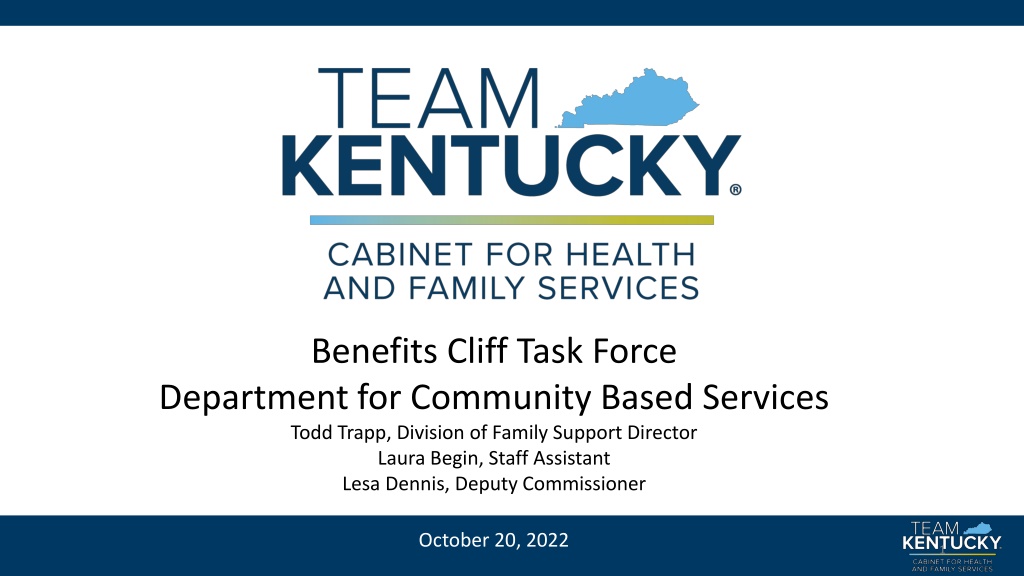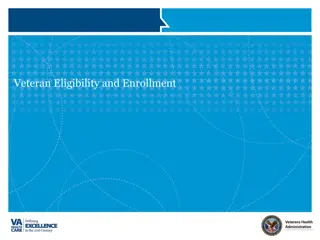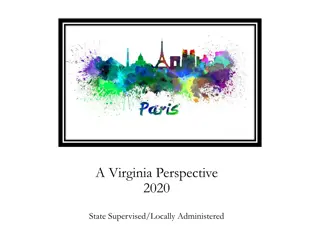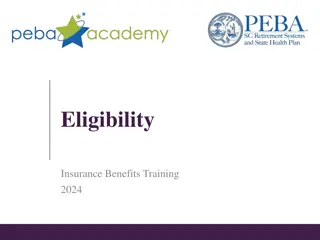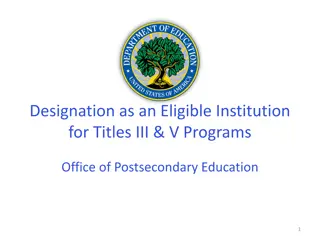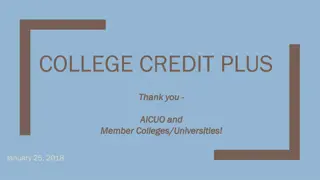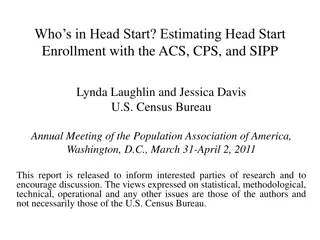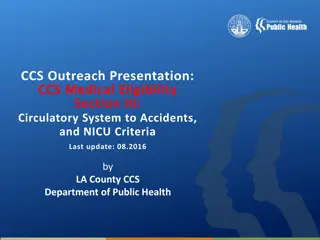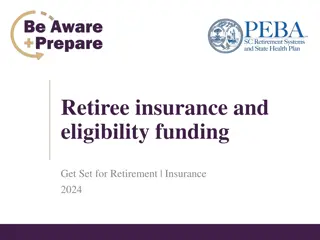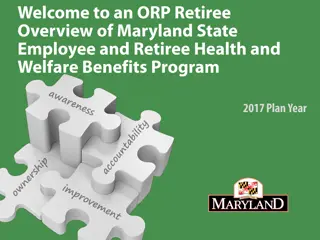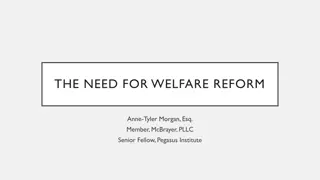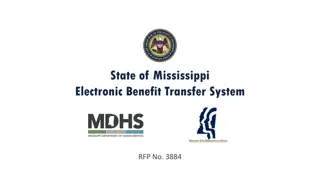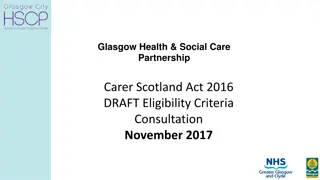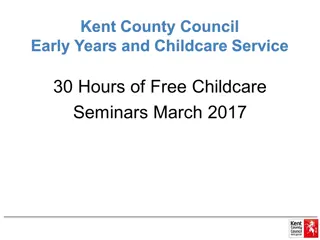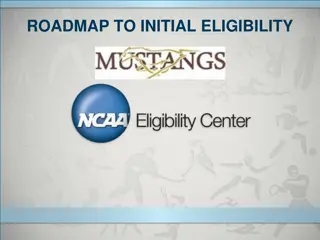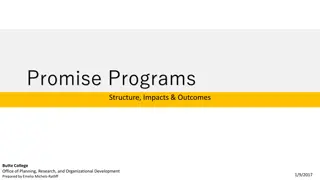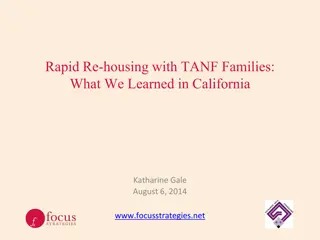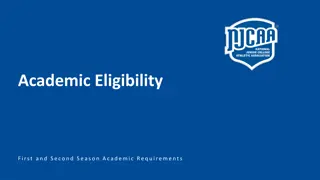Understanding TANF Programs and Eligibility Criteria
Explore the TANF-funded programs in Kentucky, such as KTAP and KWP, which aim to assist families in need through financial support, job preparation, and other services. Learn about the allowed uses of TANF funds, eligibility requirements for applicants, and the benefits provided by KTAP and KWP. Discover how these programs support needy families in achieving self-sufficiency and addressing various challenges they may face.
Download Presentation

Please find below an Image/Link to download the presentation.
The content on the website is provided AS IS for your information and personal use only. It may not be sold, licensed, or shared on other websites without obtaining consent from the author. Download presentation by click this link. If you encounter any issues during the download, it is possible that the publisher has removed the file from their server.
E N D
Presentation Transcript
Benefits Cliff Task Force Department for Community Based Services Todd Trapp, Division of Family Support Director Laura Begin, Staff Assistant Lesa Dennis, Deputy Commissioner October 20, 2022 1
TANF-Funded Programs The Kentucky Transitional Assistance Program (KTAP) and Kentucky Works Program (KWP) are 100% funded through federal TANF funds. Congress created the Temporary Assistance for Needy Families (TANF) Block Grant through the Personal Responsibility and Work Opportunity Reconciliation Act of 1996. In order to receive the full amount, states must also contribute maintenance of effort (MOE) dollars. Four purposes of TANF: 1) Assist families in need so children can be cared for in their own homes or the homes of relatives; 2) Reduce dependency of parents in need by promoting job preparation, work, and marriage; 3) Prevent pregnancies among unmarried persons; and 4) Encourage the formation and maintenance of two-parent families. 2
Allowed Uses of TANF Funds Temporary Assistance for Needy Families (TANF) funding may be allocated under these federal categories: Basic assistance Work, education, and training activities Child care Non-recurring short-term benefits Work supports and supportive services Fatherhood and two-parent family programs Child welfare services Program management (subject to a 15% cap) Refundable tax credits Pre-kindergarten/Head Start Transferred to Social Services Block Grant Out-of-wedlock pregnancy prevention 3
Eligibility for TANF Programs Must reside in the state in which individual applies; Be a U.S. citizen or legal immigrant (with restrictions); Be unemployed or underemployed with a low income; One-parent households must participate with child support; and Have a child 18 years of age or younger; Be pregnant; or Be 18 years of age or younger and head of household. 4
KTAP Provides financial and medical assistance to needy dependent children in Kentucky and their households Helps these families find work or obtain training for work May provide supportive services, such as child care, transportation, relocation assistance, etc., if requested 60-month lifetime limit Payment is based on family size and income 5
KWP Goal of assisting work-eligible individuals in supporting their families through self-sufficiency Available to KTAP participants Provides training and job-seeking assistance Provides supportive services, such as school supplies, transportation costs, or work-related needs (uniforms, tools, etc.) necessary in obtaining or maintaining work 6
Current Program Status Since the creation of TANF in 1996, there have been dramatic declines in the number of families receiving assistance nationwide. Even through the COVID-19 pandemic, TANF utilization reached a historic low. Average of 10,342 families (consisting of 3,360 adults and 17,287 children) received KTAP cash assistance per month this year (down from 13,616 families per month in 2020). TANF-funded child care assistance was provided for an average of 770 children per month. Other support services have been provided to less than ten individuals on average monthly. 7
Cause for Updates House Bill 50 (RS 2017) administrative regulations expire after 7 years pursuant to KRS 13A.3102 and 3104 Addressing dramatic declines in utilization Specifically helping two-parent families more than in the past Increasing benefit amounts from 1990s levels Addressing the benefits cliff 8
Eliminate Deprivation Factor 921 KAR 2:006 (Filed 8/4/22) Currently, a child must be deprived of parental support or care to qualify (due to the death, absence, or incapacity of a parent) For two-parent households, a child must be deprived due to the unemployment of a parent Eliminating deprivation requirements allows more children and two- parent households to be eligible for assistance while still maintaining other eligibility criteria 10
Increase KTAP Benefits KTAP benefits amounts have not changed in decades. Current monthly KTAP assistance: 11
Increase KTAP Benefits (cont.) - 921 KAR 2:016 (Filed 8/4/22) Increasing monthly amounts (rates doubled): 12
Increase Standard of Need and Gross Income Current amounts (monthly): 7 or more 13
Increase Standard of Need and Gross Income (cont.) 921 KAR 2:016 (Filed 8/4/22) Income eligibility calculation 20% increase in Gross Income 14
Increase Standard of Need and Gross Income (cont.) 921 KAR 2:016 (Filed 8/4/22) Income eligibility calculation 20% increase in Standard of Need 15
Increase Resource Limit 921 KAR 2:016 (Filed 8/4/22) The current KTAP resource limit is $2,000 per household Increasing the resource limit to $10,000 per household Allows families to build and maintain liquid resources to help support the family prior to being disqualified from KTAP 16
Other Changes 921 KAR 2:500, 2:510, 2:520, and 2:016 (Filed 8/4/22) Increasing assistance for short-term unemployment Increasing work incentive for households discontinued from KTAP due to obtaining work and exceeding income limits Increasing relocation assistance and including assistance in order to prevent homelessness Simplifying school attendance paperwork requirements for children aged 16-18 17
KWP Supportive Services 921 KAR 2:017 (Filed 9/12/22) Transportation assistance Currently $200 per month max Increasing to $300 per month max Other supportive services Currently $400 per individual per 12-month period Increasing to $600 per individual per 12-month period May include: Up to 3 uniforms, an interview outfit, licensure fees, required tools, etc. 19
KWP Supportive Services (cont.) 921 KAR 2:017 (Filed 9/12/22) Vehicle repairs Currently $1,500 per household per 12-month period Increasing to $3,000 per household per 12-month period Required fees Currently $200 max per fee Increasing to $400 max per fee May include: Training registration fee, testing fee, application fee, etc. 20
KWP Supportive Services (cont.) 921 KAR 2:017 (filed 9/12/22) Educational Bonus Currently $250 per individual Increasing to $500 per individual May include: High school diploma, GED, postsecondary degree, etc. The bonus is paid to the adult or child who receives the credential. This incentivizes pursuing further education and supports education as an integral factor in obtaining employment. 21
Questions? 22
